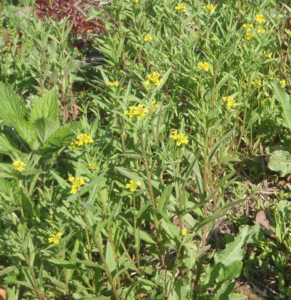 With profound sadness, we learned of the passing of Dr. J. Alan Renwick, an esteemed emeritus professor at the Boyce Thompson Institute. He passed away peacefully at home, surrounded by family, on September 18th at the age of 88.
With profound sadness, we learned of the passing of Dr. J. Alan Renwick, an esteemed emeritus professor at the Boyce Thompson Institute. He passed away peacefully at home, surrounded by family, on September 18th at the age of 88.
Born in 1936 in Monifieth, Scotland, Alan’s association with BTI began in 1960 when he joined as a research assistant in Yonkers, NY. Over the next 44 years, he was continuously engaged with BTI—as a graduate student, scientist, faculty member, and emeritus professor.
A pioneer in the field of chemical ecology, Alan made significant contributions that have had a lasting impact on our understanding of natural approaches to pest control and environmental challenges. His passion for science was evident in his prolific body of work, comprising over 140 research publications throughout his remarkable career.
Alan believed deeply in BTI’s mission to provide solutions to global problems in crop production and forestry. His passion, dedication, and countless contributions have left an indelible mark on our Institute and the scientific community.
He will be dearly missed by his colleagues and all who had the privilege of knowing him.
You may enjoy watching this recent interview with Alan as part of BTI’s Oral History project. In it, he shares his journey from Scotland to New York and some of the highlights of his career.
You may also like to read his official obituary.
Since his passing, we are collecting reflections on Alan from his former colleagues, which will be shared below. If you would like to share your memories of Alan, please email them to communications@btiscience.org.
Patricia Keen, BTI Research Specialist
I had occasion to be a guest at a 2 -year olds birthday party and Alan was a guest as well. He was soft spoken, kind, and thoughtful out of work too. A good human. He is already missed.
Alan was a friend and mentor since the very beginning of my career as a chemical ecologist. In 1996, when I started studying Arabidopsis-insect interactions as a postdoc in Boston, I contacted Alan to ask for help with glucosinolate assays. He invited me to visit BTI and was excellent host during the time that I spent in his lab. I am certain that this welcoming atmosphere contributed to my interest in applying to become a BTI faculty member a few years later. When I joined BTI in 2002, Alan was in the process of retiring from research. We shared a lab module for a few months, and I benefited greatly from his equipment, chemicals, and knowledge in the area of chemical ecology. Later, when I decided to investigate cardiac glycoside biosynthesis in wallflowers, Alan pointed out a population next to Beebe Lake that he had studied in the 1990s. Amazingly, the wallflowers were still growing in the same spot twenty years later. About five years ago, when my parents retired and moved to Ithaca, they became Alan’s neighbors and were welcomed into the local retirement community. Alan and my mother regularly played pickleball together. Last year, when it came time for Alan to move to an assisted living facility, he gave me a Schmidt and Haensch polarimeter, one of the first instruments purchased by BTI in the 1920s, which had been part of his living room décor since the move from Yonkers. This polarimeter is on a shelf in my office and serves a reminder of Alan’s friendship and contributions to the field of chemical ecology.

Wallflowers growing next to Beebe Lake.
Alan published several articles related to the chemical ecology of this species:
- Dimock MB, Renwick JA, Radke CD, Sachdev-Gupta K (1991) Chemical constituents of an unacceptable crucifer, Erysimum cheiranthoides, deter feeding by Pieris rapae. J Chem Ecol 17: 525–533
- Dimock MB, Renwick JAA (1991) Oviposition by Field Populations of Pieris rapae (Lepidoptera: Pieridae) Deterred by an Extract of a Wild Crucifer. Environmental Entomology 20: 802–806
- Huang X, Renwick JA, Sachdev-Gupta K (1993) A chemical basis for differential acceptance of Erysimum cheiranthoides by two Pieris species. J Chem Ecol 19: 195–210
- Hugentobler U, Renwick J a. A (1995) Effects of plant nutrition on the balance of insect relevant cardenolides and glucosinolates in Erysimum cheiranthoides. Oecologia 102: 95–101
- Rayor LS, Mooney LJ, Renwick JA (2007) Predatory behavior of Polistes dominulus wasps in response to cardenolides and glucosinolates in Pieris napi caterpillars. J Chem Ecol 33: 1177–1185
- Renwick JAA, Radke CD, Sachdev-Gupta K (1989) Chemical constituents of Erysimum cheiranthoides deterring oviposition by the cabbage butterfly, Pieris rapae. J Chem Ecol 15: 2161–2169
- Sachdev-Gupta K, Radke C, Renwick JA, Dimock MB (1993) Cardenolides from Erysimum cheiranthoides: Feeding deterrents to Pieris rapae larvae. J Chem Ecol 19: 1355–1369
- Sachdev-Gupta K, Renwick JA, Radke CD (1990) Isolation and identification of oviposition deterrents to cabbage butterfly, Pieris rapae, from Erysimum cheiranthoides. J Chem Ecol 16: 1059–1067

Schmidt and Haensch polarimeter, purchased by BTI in the 1920s, which Alan had in his living room for many years.
In addition to talking about science and his experience at the BTI Yonkers, NY location, Alan and I would share the latest about our families. I remember his face lighting up when he spoke about his grandchildren. I’ll miss those conversations and feel fortunate that I had the opportunity to know him.
